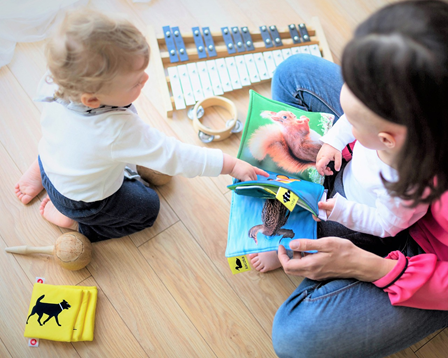10.6: Interactions that Support Cognitive Development
- Page ID
- 139907
Cognitive Development and Interactions
While materials are indeed important for supporting cognitive development, the interactions we, as caregivers, have with infants and toddlers may be even more important. Toddlers who experience more language from caregivers have greater cognitive abilities later in childhood (Brown, Wang & McLeod, 2022; Marchman & Fernald, 2008). One study examined features of childcare quality for two year olds and their potential association to later cognitive abilities when the same children were four years of age (Côté et al., 2013). Childcare quality was measured using two dimensions. The ‘Provision for Learning’ dimension measured the availability, accessibility, and diversity of activities available for children. The ‘Teaching and Interactions’ dimension measured the quality of the interaction and engagement between caregivers and children. Overall, higher levels of quality childcare at age two was associated with stronger cognitive abilities at age four. Of the two dimensions, it was the dimension of ‘Teaching and Interactions’ that was associated with longitudinal cognitive performance, supporting the role of quality interactions for cognitive growth. Interestingly, the ‘Provision of Learning’ dimension did not significantly contribute to later cognitive development.

These results are supported by numerous studies that also have found it is the quality of relationships and the interactions within these relationships during infancy and toddlerhood that are most significant for supporting cognitive development and long-term cognitive growth (Forget‐Dubois et al., 2009; Fraley, Roisman, & Haltigan, 2013; Marchman & Fernarld, 2008; McCormick et al., 2020; Rodriguez & Tamis‐LeMonda, 2011). In a longitudinal study, Tamis-LeMonda and colleagues (2019) found that the early learning environments of infants and toddlers predicted their later academic skills all the way out into fifth grade. Using the phrase “learning environment” can be slightly misleading as it may lead one to think only about the physical environment and objects/materials. While one dimension of it did focus on stimulating objects/materials, the other two dimensions focused on stimulating engagement and interactions (frequency of engaging children in literacy activities and sensitive and stimulating interactions). The research is clear: access to quality learning materials is important, but it is the quality of the interactions while using these materials that may be the most important.
What is the take away message for infant and toddler caregivers?
- Consider communication to be an integral part of the curriculum.
- If you plan an activity, do not just consider what the child will be doing, but also consider the critical role of the adult and their interactions during the activity.
- Enroll in or provide staff training that demonstrates how to improve interactions with infants and toddlers.
- Implement caregiving policies that support and encourage quality interactions, such as primary care, small groups, continuity of care, individualized care, culturally responsive care, and inclusive care.
[1] Image by ParentiPacek on Pixabay.

